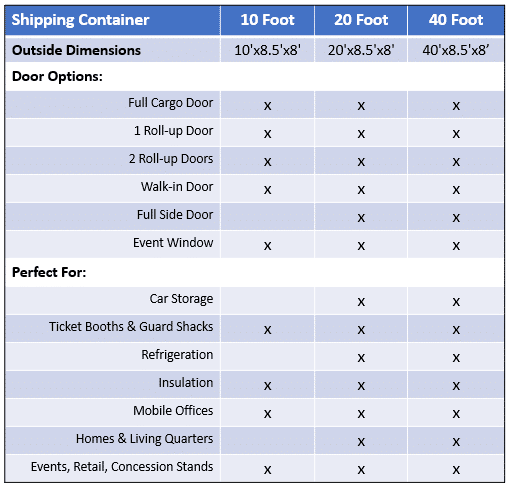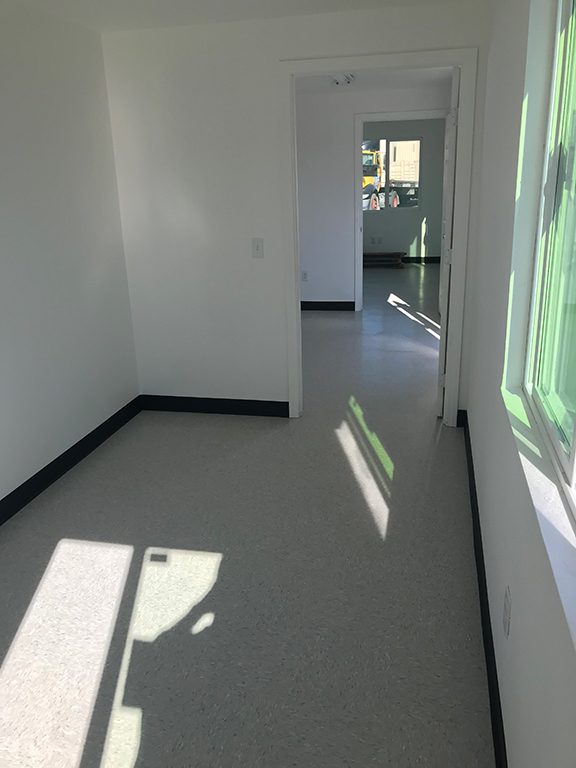How many square feet in a 40-foot shipping container? It’s 320 square feet of exterior space or around 285 square feet usable interior space.
Understanding the square footage of a 40-foot shipping container provides crucial insight for businesses and construction managers who need reliable and flexible storage solutions. These containers offer a versatile, secure, and cost-effective method to efficiently manage space constraints on-site. Their uses range from storing goods and equipment to serving as portable offices or even innovative living spaces.
My name is Steve Hyndman, and I have been with Aztec Container for over 30 years, specializing in providing top-quality shipping containers. Let’s dive deeper into the dimensions and features of a 40-foot shipping container to help you make an informed choice.
Dimensions of a 40-Foot Shipping Container
Understanding the dimensions of a 40-foot shipping container is crucial for planning its use, whether for storage, transport, or innovative applications like portable offices or homes. Let’s break down the dimensions of both standard and high cube containers, and compare their interior vs. exterior measurements.
Standard 40-Foot Container Dimensions
A standard 40-foot shipping container has the following dimensions:
- Length: 40 feet
- Width: 8 feet
- Height: 8.5 feet
These dimensions translate to an exterior area of 320 square feet. However, the interior space is slightly smaller due to the thickness of the container walls. The interior dimensions are:
- Length: 39 feet 5 inches
- Width: 7 feet 8 inches
- Height: 7 feet 10 inches
This gives an interior area of approximately 300 square feet.
High Cube 40-Foot Container Dimensions
High cube containers are designed to offer extra vertical space. The dimensions for a high cube 40-foot container are:
- Length: 40 feet
- Width: 8 feet
- Height: 9.5 feet
Despite the extra height, the exterior area remains 320 square feet. The interior dimensions are:
- Length: 39 feet 5 inches
- Width: 7 feet 8 inches
- Height: 8 feet 10 inches
This results in an interior area of approximately 300 square feet, but with additional vertical space, making it ideal for storing taller items or creating more spacious living or working environments.
Interior vs. Exterior Dimensions
It’s important to note the difference between interior and exterior dimensions. While both standard and high cube containers have an exterior area of 320 square feet, the interior area is slightly less, around 300 square feet, due to the thickness of the walls and framing.
This subtle difference can impact how you plan to use the container, whether for storage, shipping, or as a living space. For example, the extra height in a high cube container can make a significant difference in comfort and usability for residential or office applications.
Understanding these dimensions will help you make the most out of your 40-foot shipping container, ensuring it meets your specific needs and requirements.
How Many Square Feet in a 40-Foot Shipping Container?
When determining how many square feet in a 40-foot shipping container, it’s important to distinguish between the different types of containers. Both standard and high cube containers have similar floor space but differ in height.
Standard Container Square Footage
A standard 40-foot container has exterior dimensions of 40 feet in length, 8 feet in width, and 8.5 feet in height. This gives it an exterior floor space of 320 square feet. However, the interior space is slightly reduced due to the thickness of the walls and framing.
- Exterior: 320 square feet
- Interior: Approximately 300 square feet
Example: A small business owner used a standard 40-foot container to store seasonal inventory. The 320 square feet of exterior space provided ample room, while the 300 square feet of interior space was more than sufficient to organize and access items easily.
High Cube Container Square Footage
A 40-foot high cube container has the same exterior floor dimensions but adds an extra foot in height, making it 9.5 feet tall. Despite this added height, the floor space remains the same as the standard container.
- Exterior: 320 square feet
- Interior: Approximately 300 square feet
Example: A startup converted a 40-foot high cube container into a mobile office. The extra foot of height significantly improved the comfort and usability of the space, providing a better working environment while maintaining the same 320 square feet exterior and 300 square feet interior floor area.
Understanding the square footage of both standard and high cube 40-foot shipping containers is crucial for planning their use, whether for storage, commercial purposes, or innovative residential projects.
Uses of a 40-Foot Shipping Container
Commercial and Industrial Uses
40-foot shipping containers are incredibly versatile in the commercial and industrial sectors. Their robust design and ample space make them ideal for various applications.
Construction Sites: These containers are perfect for storing tools, equipment, and materials securely. They can be easily transported to different job sites, providing a reliable and portable storage solution.
Retail Storage: Retail businesses often use 40-foot containers to store seasonal inventory or excess stock. Their large capacity ensures that retailers have enough space to keep their products safe and organized.
Manufacturing and Warehouse Storage: Manufacturers and warehouses use these containers to store raw materials and finished goods. The 320 square feet of space allows for efficient organization and easy access to stored items.
Residential and Innovative Uses
The flexibility of 40-foot containers extends beyond commercial uses. They are increasingly being adapted for residential and innovative purposes.
Container Homes: One of the most exciting uses of 40-foot containers is in the creation of container homes. These homes are cost-effective, eco-friendly, and quick to build. With proper insulation and interior finishing, a 40-foot container can become a comfortable living space.
Portable Offices: As remote and hybrid work models grow, businesses are converting containers into portable offices. These offices can be outfitted with insulation, electricity, and internet, providing a flexible and affordable workspace.
Emergency Housing: In times of crisis, 40-foot containers can be quickly converted into emergency housing. Their sturdy construction and portability make them ideal for providing immediate shelter to those in need.
Indoor Gardens: Some innovative gardeners are using 40-foot containers to create indoor gardens. With the right ventilation and lighting, these containers can be transformed into controlled environments for growing plants year-round.
Example: A company in California transformed several 40-foot containers into pop-up retail spaces for local artisans. The containers provided secure, weatherproof environments that could be easily moved to different locations, offering a flexible solution for temporary retail setups.
The uses of a 40-foot shipping container are as varied as your imagination. Whether you need storage, a commercial space, or a unique residential solution, these containers offer a practical and adaptable option.
Features and Customization Options
Standard Features
When you get a 40-foot shipping container, it typically comes with several standard features that make it durable and versatile:
-
14-Gauge Cor-Ten Steel: These containers are made from high-quality Cor-Ten steel, known for its durability and resistance to rust. This makes them ideal for long-term storage and harsh weather conditions.
-
Ground-Level Access: This feature makes it easy to load and unload items, especially heavy equipment and machinery.
-
Lockable Double Doors: Standard containers come with basic lockable double doors. These doors are secure and provide a wide opening for easy access.
-
Plywood Flooring: The floors are usually made from thick plywood, offering a sturdy base for whatever you choose to store or set up inside.
Customization Options
While standard features provide a good starting point, you can customize your 40-foot shipping container to meet specific needs. Here are some popular modifications:
-
Different Types of Doors: You can replace the standard double doors with roll-up doors, personnel doors, or even sliding glass doors depending on your use case.
-
Ramps and Wheels: Adding ramps can make it easier to move items in and out, especially if you’re storing heavy equipment. Wheels can make your container portable, turning it into a mobile unit.
-
Shelving: Installing shelving units can help you maximize the internal storage space, keeping everything organized.
-
Ventilation: Proper ventilation is crucial, especially if you’re using the container for storage or as a workspace. Options include adding vents or even air conditioning units.
-
Insulation: Insulating your container can make it suitable for different climates. Spray foam insulation is a popular choice as it fills gaps and provides a moisture barrier.
-
Windows and Interior Finishing: Adding windows can bring in natural light, making the space more comfortable. Interior finishing options include drywall, paneling, and custom paint to make the container feel more like a traditional building.
These customization options can turn a basic 40-foot container into a tailored solution for various needs. Whether you’re looking for extra storage, a portable office, or even a livable space, the possibilities are endless.
Next, we’ll dive into some frequently asked questions about 40-foot shipping containers to provide further clarity.
Frequently Asked Questions about 40-Foot Shipping Containers
What is the Weight of a 40-Foot Shipping Container?
Understanding the weight of a shipping container is crucial for logistics and planning. A standard 40-foot shipping container weighs about 8,300 pounds (3,750 kg). If you’re considering a 40-foot High Cube container, it weighs a bit more, around 8,800 pounds (4,000 kg).
How Much Can a 40-Foot Shipping Container Hold?
The capacity of a 40-foot shipping container is impressive, making it a versatile option for various uses. Both standard and high cube containers can handle a payload of up to 63,000 pounds (28,576 kg). This makes them ideal for heavy-duty storage and transportation needs.
In terms of volume, a standard 40-foot container offers about 2,720 cubic feet of space. The high cube variant provides even more room, with approximately 3,040 cubic feet of interior volume. This extra space can be a game-changer for projects requiring additional height.
What are the Interior Dimensions of a 40-Foot Shipping Container?
Knowing the interior dimensions helps in planning how to utilize the space effectively. For a standard 40-foot container, the interior dimensions are:
- Length: 39 feet 5 inches
- Width: 7 feet 8 inches
- Height: 7 feet 10 inches
For a 40-foot High Cube container, the interior dimensions are slightly different due to the extra height:
- Length: 39 feet 5 inches
- Width: 7 feet 8 inches
- Height: 8 feet 10 inches
These dimensions provide a clear understanding of the usable space inside the container, helping you plan for storage, transport, or even conversion into livable spaces.
Next, let’s explore the various uses of a 40-foot shipping container to see how versatile these units can be.
Conclusion
In summary, a 40-foot shipping container offers substantial space and versatility. Whether you’re looking at a standard container or a high cube, the dimensions provide ample room for various applications. The exterior dimensions are 40 feet in length, 8 feet in width, and either 8.5 feet or 9.5 feet in height, offering 320 square feet of exterior space. Internally, you get approximately 300 square feet to work with.
These containers are not just for shipping goods; they are increasingly used for storage, commercial, industrial, and even residential purposes. From construction sites to innovative container homes, the possibilities are endless.
At Aztec Container, we specialize in providing high-quality shipping containers that meet your specific needs. We offer a range of customization options, from insulation and ventilation to specialized doors and interior finishes. Our goal is to ensure you get the perfect container for your project.
If you’re ready to explore the potential of a 40-foot shipping container, visit our 40-foot containers page for more information and to get a quote.
For any questions or to discuss your specific requirements, contact us. We’re here to help you every step of the way.
Feel free to reach out to Aztec Container for more details and to get started on your next project.
Thank you for reading!







